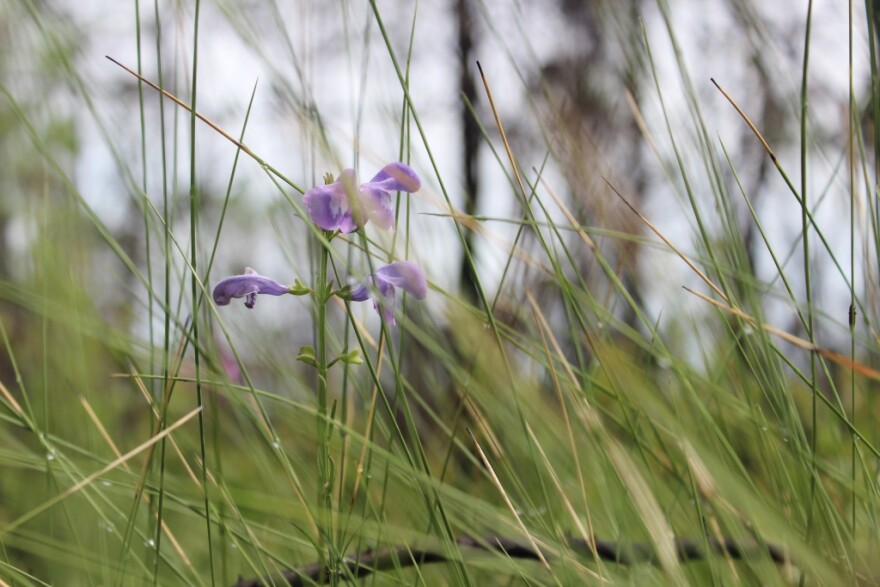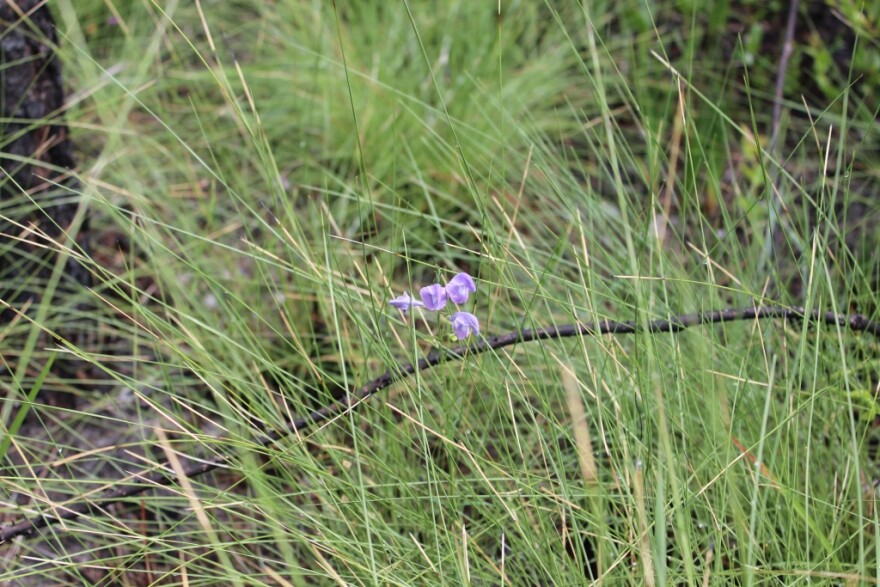Allix North and Dylan Shoemaker are trudging through a marsh to a small clearing full of threatened and endangered wildflowers. After a controlled burn in the St. Joseph Buffer Preserve the rare flowers are in bloom. The going isn’t terribly difficult, but it is a bit wet.
Shoemaker is the preserve’s manager, and North’s official title is park services specialist. But more to the point, she’s the biologist who found the new patch of Chapman’s crownbeard, Florida skullcap, and tropical waxweed.. It’s a good thing she found the spot when she did – the flowers don’t stay in bloom very long.

North says Chapman’s crownbeard is usually the easiest to catch because it’s about two feet tall and has bright, dandelion-yellow petals when it’s in bloom. Fully flowered, it looks kind of like a brown ball covered with tiny golden cup-shaped blossoms. Already most of the crownbeards have lost their petals.
But there is a Florida skullcap.
Florida skullcap is lavender, and just to be clear, it really looks nothing like a skull. But that doesn’t mean it’s easy to describe. Imagine two vaguely pear-shaped petals forming a kind of cone at the narrow end. This is what connects to the stem. At the broader end, where the flower opens, the bottom petal curls down and outward, kind of like someone sticking out his tongue. The top petal lifts up with the sides curling inward. Florida skullcap, or at least this plant, is tiny - no more than 8 inches tall.

And here’s where prescribed fire comes in: without it to clear the undergrowth, it’s unlikely this flower could get enough sunlight to grow.

One of the plants fire helps to manage is called titi. Left alone, it grows into a tangled, bushy wall, and in some areas of the preserve the brush stretches more than 10 feet high. Titi is native to the area, but North says it can choke out other plant life if it isn’t cleared regularly.
“The plant itself resides in bogs and wet areas,” North says, “but with the exclusion of fire it expands and becomes more of an intrusive plant that shades out all of the ground cover”
But the park has a deeper purpose as well. Water has to flow through the preserve to reach St. Joseph Bay, and Shoemaker says the park serves as a buffer, purifying the water as it passes through.
“It’s a big landmass that, since there’s no development, no septic tanks, nothing like that on the land, all the water that comes in, from Deep Oak Creek, or the wetlands, is filtered before it gets to the bay,” Shoemaker says.
Throughout the preserve, the staff has created low water crossings by building long dips into the dirt road so water can flow across naturally rather than being diverted. Money Bayou cuts right across the road. The bayou may be five feet across today but North says she’s seen it grow to almost 50 – turning the crossing into a slow-moving swamp.

Money Bayou is fed by the same marsh where North found the wildflowers, and from this crossing it flows into another wetland, before eventually feeding into the bay. North says the water’s course creates a series of unique ecosystems that form a unified picture.
“It’s just this interesting mosaic of plant communities, and how the water accumulates or doesn’t accumulate determines where your plants are at,” North says.
And at just over 5000 acres, Shoemaker says the buffer preserve connects a lot of different pieces.
“Ten to fifteen, probably. I mean if we broke them all down between sand hill, and wet flat woods, mezic flat woods, cypress domes, I mean there’s many, many – wetland strands, marshes – there’s a lot of different communities that play a big part here,” Shoemaker says.
At the St. Jospeh Bay Buffer Preserve, fire and water are working together. The water supports ecosystems where plants can grow, and the fire gives them the room to do so. For a handful of rare flowers, both are crucial.

The preserve is open to the public daily from sunrise to sunset and there are trails for hiking, biking and horseback riding. The staff offers tram tours of the preserve on first Fridays every month except July and October.


